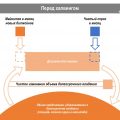How Bitcoin and Lightning Network micropayments could shape the gaming industry in the coming years.
Approx. translator: all references to the sources (English) of the data used are given by footnotes in original article... They are only partially left in the translation.
The gaming industry, which has historicallydominated by large companies, has been in continuous development in recent years, influenced by technological innovation and changing consumer needs. As a result of rapid growth, the total gaming industry volume exceeded $150 billion in 2019, an increase of approximately 10% year over year. For the first time, the gaming market size has surpassed the audio and video markets combined, becoming the most profitable form of leisurely entertainment.
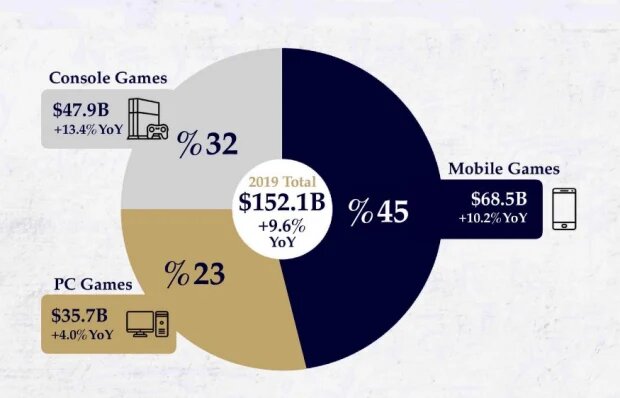
The size and growth of the gaming market, by platform. ()
Most of the modern gaming ecosystemlives and thrives on massive multiplayer platforms. Many of these platforms have developed and developed over time domestic markets and economies with their own currencies, which players use to buy and sell virtual goods and services. These platforms are simultaneously platforms for communication, content creation and social interaction.
Evolution of business models in games
Looking back at the history of this industry, we went throughthrough changes not only in accessibility, changing PCs and consoles to mobile devices, but also in business models. Gaming ecosystems have evolved from a single-player gaming model to gaming economies based on multiplayer platforms.
Activision Blizzard received in 2020$5.74 billion in revenue from microtransactions and downloadable content, subscriptions, product and franchise royalties, and other revenue. Sales of gaming products accounted for only a third of the company's revenue - 50% less than in 2014, when they accounted for almost two-thirds of the company's revenue (source, PDF, English).
About 85% of the revenues of these gaming economiesdue to the costs of users within the platforms in the form of purchases of virtual goods, that is, in-game transactions. Ranging from $ 5 to $ 12 (source, PDF), these transactions have replaced one-off product sales as the main source of revenue. The remaining revenue streams are retail and digital sales, downloadable content, and advertising.
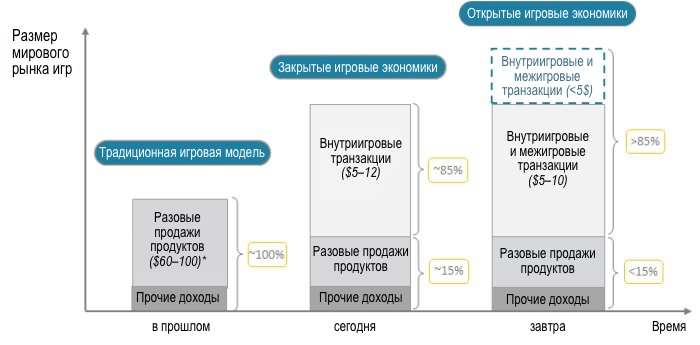
The evolution of business models in the gaming industry.
* One-time sales of video games on discs
The chart shows the rising valuein-game transactions for new business models in the gaming industry. Together with other technologies such as the Internet, which has opened up new distribution channels, and the development of computing systems for more complex gaming processes, in-game transactions have been able to create tremendous value that is reflected in the size of the gaming industry market today.
However, many games are designed in such a way thathave domestic markets with their own currencies that fuel their economies. Gamers have to use specific in-game transaction mechanisms to buy and sell virtual goods or services. Limited interaction between stakeholders leads to closed systems and prevents further value generation. When a player leaves an ecosystem, he loses all the value he has accumulated in that ecosystem.
Studies have shown that interactions in gamesare of paramount importance, influencing both pleasure and player engagement. Thus, interactions between users are of particular interest when optimizing player engagement.
Value streams, as a very direct expression of social exchange theory, are the driving force behind user interactions and therefore the driving theme of this article.
Having first outlined how value streams move today and where value remains locked in games, I will provide ways to unlock it, drawing on a brief case study.
From unidirectional to bidirectional value streams in games
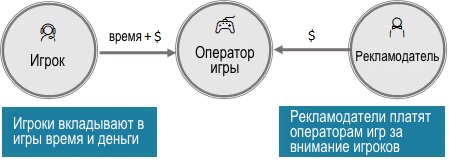
Simplified illustration of traditional value streams in games
Modern games are characterized by largely unidirectional value streams from various stakeholders directly into the game, as shown in this simplified graph.
In addition to the value of the game itself, we assume that the greatest value is created by the player through in-game activity and cash contributions.
Therefore, the article is devoted to describing value streams from the perspective of the player and reveals four areas in which value is accumulating today:
- digital assets (for example, skins) purchased within the game for cash contributions;
- specific in-game points or currencies obtained in exchange for the player's time spent;
- attention to brand advertising as a result of time spent;
- play skills for creating entertaining content for the audience as a result of time spent.
Following the trend of decreasing transaction sizesin games, Bitcoin and its second-tier payment network, the Lightning Network, allow players to unlock the value accumulated in the listed areas and form bi-directional value streams between participants in the gaming ecosystem.
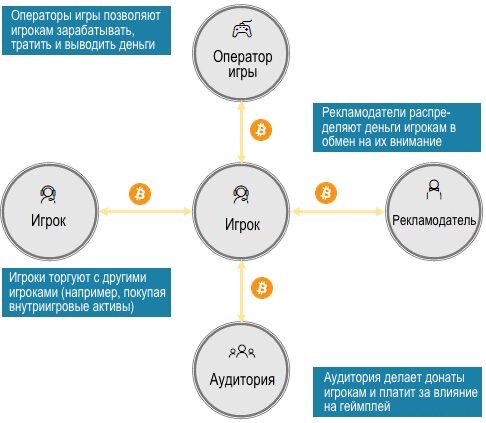
Value streams with p2p micropayments in BTC powered by Lightning Network
Lightning Network is decentralizeda system for handling high volume micropayments with low transaction fees and user privacy. It is built on top of Bitcoin while maintaining its core properties: fixed supply, peer-to-peer payments, network security, liquidity, and availability. From this list of characteristics alone, you can see that Bitcoin offers its users unique advantages over fiat money or other cryptocurrencies, and that it is great for the global multinational gaming ecosystem.
The following sections show how micropaymentson the basis of Bitcoin create opportunities for social interaction through new bidirectional value streams between existing participants in the gaming ecosystem. Gamers, developers and publishers, advertisers and audiences can all make money p2p transactions among themselves without relying on intermediaries, as shown in the diagram above.
Micro payments between players and game operators
In this section, we will talk aboutbidirectional cash flows between gamers and game operators and the benefits they bring to both sides. The concept of gambling for money, where players are rewarded for investing their time and money in the game, is not new in the gaming industry, but it is an established business model in gambling and esports.
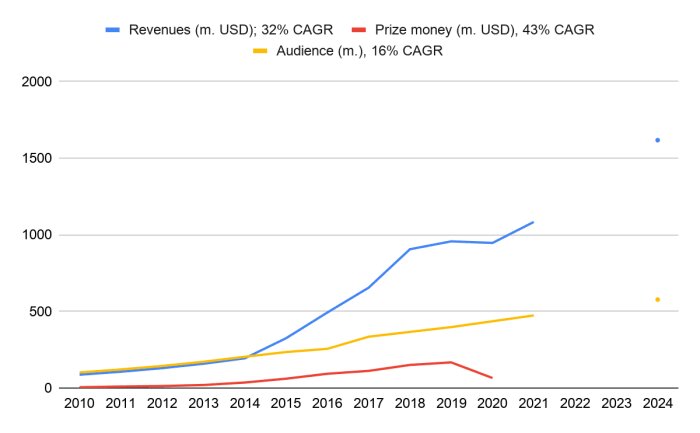
Global revenues (blue curve), prize money (red), and audience (yellow) in esports from 2010 to 2021, with a projected revenue and audience until 2024
Over the past 10 years, the eSports industryis on an impressive growth trajectory, outpacing the global gaming market. The eSports market size, as measured by industry revenue, has grown 30% annually, reaching $1.084 billion in 2021 and expected to grow to $1.617 billion by 2024. Prize money paid to players and audience size between 2010 and 2020 show a similar upward trend. The COVID-19 pandemic caused a slight decline in market size and overall prize payouts in 2020, but audience engagement continued to rise, indicating the gaming industry's resilience compared to many others.
The rise in prize money contributed to the accelerationprofessionalization of the industry. The large prize pool attracts new players and a large following, creating a positive feedback loop, and can be seen as a valuable tool for launching new markets such as the esports market.
Figures from India show that the games are for realmoney (real money games, RMG) in 2019 accounted for 55-60% of the revenue of the entire gaming market. However, only 20% of all online players are registered users of real money games, which indicates a higher monetization per user in RMG. Since RMG operators make up about 40% of online game development companies, these operators, on average, generate more revenue than their non-RMG counterparts.
RMG companies often operate on a commission-based modelservice, withholding part of the entry fee (usually 5-15%), and distributing the rest as winnings. Monetary risk creates a sense of personal interest in the outcome of the game in players, significantly increasing the level of engagement.
Random giveaways and rewards is another onegame design that allows real cash flows to create additional incentive in the gameplay. THNDR Games, a lightning game company, uses lottery to motivate players. Players collect THNDR tickets to participate in the drawing. Each ticket entitles you to a raffle in which prizes in BTC are distributed. Winners can instantly withdraw their winnings to their Lightning-enabled bitcoin wallet.
Anticipating future rewards, as players are never sure when the next big item will hit, adds to the fun and motivates players to stay in the game longer.
To summarize, bidirectional value streamsbetween the game operator and the player are an established concept in the gaming industry. The esports case study and Indian market statistics show how real money games can bring added value to gaming operators. Cash payments professionalize ecosystems, facilitate the development of monetization strategies, and, in particular, allow new forms of game design with higher levels of engagement.
But there are even more economic benefits to establishedcompanies can benefit from the use of bitcoin and lightning payments in games. More granular peer-to-peer payments can help build a fairer system between game creators and users by proportionally distributing revenue generated along the value chain. For example, players pay to access special areas on maps. The proceeds are shared directly between all co-authors and organizers - content creators, game developers and operators. Thus, Bitcoin-based bi-directional value streams could potentially even help gamers and game creators who cannot afford high upfront investments or simply lack access to banking services (like hundreds of millions of people in developing countries) to participate in the global gaming economy. That is, use cases in games can be another factor contributing to the spread of Bitcoin, and ecosystems in the gaming industry can form the basis for their own circular economy based on Bitcoin.
Micropayments between players
This section describes the use of secondary markets by game operators as a way to implement exchange of monetary values between players using Bitcoin.
Selling virtual goods in in-game purchases has become the dominant business model in the gaming industry.
In the primary market, the gaming operator sells newvirtual goods to users for real money and therefore acts as a monopolist, setting prices in a way that maximizes profits.
After the sale of the product on the primary market, anyfurther trading operations with it take place in the secondary market. In virtual worlds, users buy and sell virtual assets to each other, often exchanging them for real money or in-game currencies. Prices are set by the users themselves and are determined by supply and demand. Secondary markets arise for the same reasons as their counterparts in real life: there are consumers who value used goods higher than their current owner. Healthy primary markets tend to give rise to even larger secondary markets.
For example, to the primary car marketaccounts for a fairly small percentage of total car sales compared to the secondary market. The same can be said for real estate and many other industries. The virtual goods economy is another example of how a strong primary market can lead to a thriving secondary market.
Specialized trading platforms have appearedfor virtual game items, such as G2A, Loot.Farm or DMarket. But Discord, Reddit, eBay and many other chats and forums also serve as trading platforms. Juniper Research estimates that the total value of gaming items listed on the secondary market was $16.7 billion in 2019. As these virtual goods markets continue to grow, questions surrounding business models become increasingly pressing. Why should profit-maximizing virtual world operators exploit these secondary markets instead of eliminating them?
In fact, research shows that the marketsecond-hand goods managed by retailers increase the profits of manufacturers for two reasons. First, the sale of used goods serves as a price discrimination mechanism, thereby increasing sales and profits. Second, the existence of a retailer-driven secondary market creates the conditions for higher appreciation of new products by allowing consumers to resell on the secondary market what has lost their value in their eyes.
Release of new versions of goods is another strategy,which can be used by a monopolist to protect profits in the primary market from the substitution effect. Players will spend more time in the game - either to get new items, or to collect enough in-game currency to buy an item - or simply buy them with real money; both increase engagement in the game.
In addition, market operators can usenew transaction models, such as renting their products instead of selling them or buying them back. The latter option gives the market operator more control over the available supply and the ability to make money on the price difference.
These measures show how and why secondary marketshave a positive effect on the profits of the primary market, provided that the operator of the virtual world takes measures to mitigate the substitution effect caused by used goods.
Satoshi's Games, another gaming company onbased on the Lightning Network, already provides developers with the necessary set of tools, called Elixir, to add Bitcoin-enabled gaming assets to games. Building on the Liquid, IPFS and L-SAT sidechain, Elixir brings the concept of non-fungible tokens (NFT) to Bitcoin and makes them available for decentralized trading.
In a nutshell, this section describesuse of secondary market trading platforms based on real money. Examples show how bidirectional value streams between players in secondary markets can generate additional value for operators and players. With peer-to-peer architecture, high availability and liquidity, coupled with instant and cheap confidential payments, bitcoin transactions through the Lightning Network simplify the marketplace while lowering transaction costs for both players and operators. A market that is natively powered by the Lightning Network, if possible, could potentially provide access to even more liquidity and a better user experience.
Micro payments between players and audience
This section focuses on the interaction between players and audiences in live streaming format with Bitcoin-based micropayments.
Live streaming means recording and simultaneously streaming content (including games) to an audience through social platforms like Twitch or YouTube.
Increased audience due to the pandemiclive broadcasts of game play will reach 728.8 million people in 2021. The number of people watching such broadcasts will increase by 10% from 2020 and will continue to grow to 920.3 million people by 2024.
Although most of the content on platforms forLive streaming is free, viewers can financially support streamers in a variety of ways, including monetary donations or a monthly subscription to the streamer's channel. However, much of the value goes directly to the streaming platform, bypassing the gamer. Roughly 50% of subscription revenues and about 25% of subscriber donations go to Twitch. Viewers and gamers alike have to abide by the platform's rules that restrict interaction from both sides.
That is why ZEBEDEE was founded.According to André Neves, CTO at ZEBEDEE, “Internet value is no longer tied to a game, platform or game universe. Now internet money is accepted in any of the worlds, in any reality. The language of Bitcoin is spoken by all the worlds. " ZEBEDEE provides a suite of products - from a mobile wallet to an Infuse product and a developer dashboard - to embed BTC payments into existing games. To solve the mentioned problem and break down the "fourth wall" [between the gamer and his audience], they introduced Gamertag, a gamertag representing a username in the ZEBEDEE ecosystem. Together with it, a QR code is created to collect donations or payments anywhere online. Now streamers can receive donations in the form of real money and messages from viewers without commissions from third-party processing companies or other intermediaries.
For the audience, the benefits are clear.Traditional audiences are homogeneous, static and often passive, but multiplayer p2p micropayment games give game designers the opportunity to change traditional roles and allow the audience to influence the gameplay both individually and collectively. For example, in a racing game, if the streamer is too far ahead, the audience can impose some kind of restrictions or penalties on him to make the race more interesting. When a streamer falls behind the race as a result of these measures, the audience can respond by sending him gifts to help catch up. In other words, in this situation, the audience plays a role usually played by gaming systems: balancing the player's performance in relation to his opponents.
As a result, this form of gaming, combined with peer-to-peer micropayments, creates a mutually aware group of audience and players.
On the other hand, the success of streamers is largelydepends on their ability to entertain the audience through direct participation. Real money micropayments, as we have seen, expand the range of possible interactions. But there is another side: if streamers expect to play a game with thousands of viewers on an ongoing basis, earning income from donations, sponsorships or advertising, they can afford to spend much more on the game than most individual users are willing to pay.
Hence, game developers and publishersbenefit from increased player and viewer engagement as well as increased cash flow to gamers. For example, a feature that allows viewers to pay to activate an in-game event, such as freeing an enemy that the player will fight. Thus, micropayment interactions expand the possibilities for game monetization.
In addition, the development of new, richermodes of communication, such as a messaging layer integrated with Lightning, can significantly contribute to the development of a sense of social inclusion and group commitment in the gameplay. It might even make sense to create games for a specific segment of players and viewers who benefit from the ability to collaborate to achieve a goal.
These examples show how micropayments onreal money can bring innovation to the development and distribution of games for developers, publishers and gamers alike. Games with the participation of spectators and p2p micropayments allow viewers, through their interaction, to have a significant impact on the game and, through this, blur the line between the player and the viewer.
Micro payments between players and advertisers
In the final subsection, we'll talk about the potential ways to organize and the benefits of Bitcoin-based micropayments for advertisers.
In-game paid advertising revenue was $42.3 billion in 2019 and is expected to continue its strong growth to $56 billion by 2024.
Although some publishers are already using manyavailable ad formats to monetize their users, others are just beginning to realize the potential of advertising. This is because the type of ad that is suitable is highly dependent on the genre of the game. Understanding the user's journey through the game is the best start to knowing which ad formats to integrate and where.
There is a common misconception thatthat in-game ads harm in-game metrics such as user retention or in-app purchase revenue. However, when properly integrated, in-game ads actually add value and do not affect game preservation, as the example of Bitcoin Bounty Hunt demonstrates.
Donnerlab, developer of Bitcoin Bounty Hunt,uses a new interactive in-game advertising model. Advertisers create images with credit balances measured in satoshi. These images are selected by an algorithm and displayed on billboards in the game. When you select an image, credits are deducted and become available in the game in the form of satoshi cubes. Each time a player picks up one of these satoshi cubes with an advertiser image, his BTC balance is increased.
To participate, sponsors can create their ownimages or help others become more visible in the game by increasing their credit. In this way, Bitcoin Bounty Hunt creates a bi-directional value stream directly between players and advertisers and helps build positive relationships between them.
Survival CS Mode:GO by ZEBEDEE is another example of how advertising can be linked to player payouts. In addition to advertising banners placed on cards within the game, players earn sponsor-branded coins that are generated on cards as they progress. These custom coins are paid out in real Satoshi. However, there is another innovation in CS: GO survival mode. The amount of satoshi on the balance sheet reflects the amount of "health" of the player in the game. To continue playing, players must bet their own or earn real money by actively collecting rewards scattered around the map. But they also potentially endanger themselves by becoming more visible to other players. This risk, combined with real money, adds a new incentive structure to FPS gameplay.
Open approach to in-game advertising especiallyimportant when you consider that only 3.8% of mobile game users make in-app purchases. Advertisers have the ability to reward players for their attention with direct cash payments and instantly return the value back to the player. Increased interactivity can result in players becoming more involved in the gameplay and leading to a higher brand response, that is, more memorable and supportive brand.
Ultimately, in-game ad revenuecorrelate with the time spent by users and the possibilities of displaying ads. Therefore, developers will optimize gameplay to retain players and increase their engagement and enjoyment. Thanks to Bitcoin-based micropayments, developers now have a new tool to support interactions and create added value for the player and advertiser.
About perspectives
This article introduces the various stakeholders of the virtual gaming economy: game operators, gamers, their audiences, and advertisers.
Today, the value of the virtual economy is the mostclearly manifests itself in massive multiplayer platforms. After fifteen years of massive adoption of virtual games, the virtual economy is still largely based on primary marketplaces - closed worlds where data and content are centrally stored and managed by centralized owners. However, a number of pioneers, some of whom have already been mentioned in this article, are creating for the virtual economy what scientists created for the early Internet - a new infrastructure that connects disparate platforms in a decentralized manner.
Having first outlined the traditional game model withunidirectional payment flows, we looked at examples of how bidirectional flows can unlock additional value that remains blocked in today's closed ecosystems. The use of Bitcoin-based micropayments and the Lightning Network between gamers, their audiences, advertisers and game operators is becoming part of an open virtual economy, or what could grow into a future digital “metaverse”.
If separating payments from platforms usingA digital p2p currency such as Bitcoin is one step towards this vision of the metaverse, a self-contained digital identity that players could use across all game worlds is another component of the future metasystem with great potential but not yet found.
Several dominant systems exist todayaccounts, but none of them have an exhaustive network coverage and, with very limited data exchange, they often overlap. As a result, separate identity stores have emerged to provide trust within a particular federation of organizations or centralized platform providers. The consequences for users are lack of privacy, limited data control and poor service.
But what if developers can useBitcoin not only to ensure interoperability of payments on gaming platforms, but also to securely transfer personal data and assets between trusted domains?
The good news is that the tools needed to do this already exist in various forms:
LSAT Protocol Standard can serve asan authentication mechanism and a payment mechanism. This allows the authentication and payment logic to be decoupled from the application logic. Gaming operators can sell their products or services through micropayments without the need to provide users with a login, email or password.
lnurl-auth is another protocolauthentication that ensures confidentiality and makes familiar passwords obsolete. Bitcoin and lightning wallets already track a single seed that can be used to generate user identification keys, making it easier to download the protocol. The service can prompt the user for additional information and associate it with an internal id or username.
ION is a public public networkdecentralized identifiers (DID), implementing the blockchain-independent Sidetree protocol on top of Bitcoin. Like Lightning, ION is a second-tier solution to support DID and Decentralized Public Key Infrastructure (DPKI) at any scale. When combined with verifiable credentials, the effect is powerful. Users have full control over their identity and can share it with any game as needed. Operators can instantly verify user credentials without having to trust their owner.
If secure credentials areone part of the task, then the transfer of identification data and, at the same time, information about the ownership of digital assets is the other part. Typically, player assets such as clothing and weapon skins can only be used in one game and remain tied to one account after purchase. Increasingly, this problem is solved through the use of NFT.
Liquid Network, Bitcoin's sidechain, allowsissue new digital assets. The amounts and types of assets in the Liquid Network are not visible to third parties (that is, confidential), and the interval between blocks is exactly one minute.
More about Liquid Network
RGB, another initiative, isa system of smart contracts based on the Lightning Network, designed to create various forms of fungible or non-fungible assets. RGB smart contracts are designed to work with a client-side validation paradigm, that is, all data is stored outside of a bitcoin transaction. This allows the system to run on top of the Lightning Network without any changes and creates conditions for a high level of scalability and protocol privacy.
As these tools evolve and gain popularity among game developers, an open virtual economy powered by Bitcoin may become a reality.
</p>

